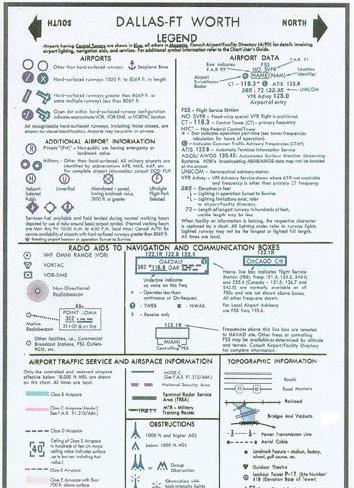8-1
CHAPTER 8 - NAVIGATION
INTRODUCTION
This chapter provides an introduction to cross-country flying
under visual flight rules (VFR). It contains practical information for
planning and executing cross-country flights for the beginning pilot.
Air navigation is simply the process of piloting an airplane from
one geographic position to another while monitoring one’s position as the
flight progresses. It introduces the need for planning, which includes
plotting the course on an aeronautical chart, selecting checkpoints, measuring
distances, obtaining pertinent weather information, and computing flight
time, headings, and fuel requirements. The methods used in this chapter
include pilotage—navigating by reference to visible landmarks, dead reckoning—computations
of direction and distance from a known position, and radio navigation—by
use of radio aids.
AERONAUTICAL CHARTS
An aeronautical chart is the road map for a pilot flying under
VFR. The chart provides information which allows pilots to track their
position and provides available information which enhances safety. The
three aeronautical charts used by VFR pilots are:
• Sectional Charts
• VFR Terminal Area Charts
• World Aeronautical Charts
A free catalog listing aeronautical charts and related publications
including prices and instructions for ordering is available upon request
from:
NOAA Distribution Branch (N/CG33)
National Ocean Survey
Riverdale, MD 20737-1199
Telephone: (301) 436-6990
Sectional Charts
Sectional charts are the most common charts used by pilots today. The
charts have a scale of 1:500,000 (1 inch = 6.86 nautical miles or 8 statute
miles) which allows for more detailed information to be included on the
chart.
| The charts provide an abundance of information, including
airport data, navigational aids, airspace, and topography etc. Figure 8-1
is an excerpt from the legend of a sectional chart. By referring to the
chart legend, a pilot can interpret most of the information on the chart.
A pilot should also check the chart for other legend information which
includes air traffic control frequencies and information on airspace. These
charts are revised semiannually except for some areas outside the contiguous
United States where they are revised annually.
Visual Flight Rule (VFR) Terminal Area Charts
Visual flight rule terminal area charts are helpful when flying
in or near Class B airspace. They have a scale of 1:250,000 (1 inch =3.43
nautical miles or 4 statute miles). These charts provide a more detailed
display of topographical information and are revised semiannually, except
for several Alaskan and Caribbean charts.
World Aeronautical Charts
World aeronautical charts are designed to provide a standard series
of aeronautical charts, covering land areas of the world, at a size and
scale convenient for navigation by moderate speed aircraft. They are produced
at a scale of 1:1,000,000 (1 inch = 13.7 nautical miles (NM) or 16 statute
miles). These charts are similar to sectional charts and the symbols are
the same except there is less detail due to the smaller scale. These charts
are revised annually except several Alaskan charts and the Mexican/Caribbean
charts which are revised every 2 years. |
|
|
Figure 8-1.—Sectional chart legend.
|
